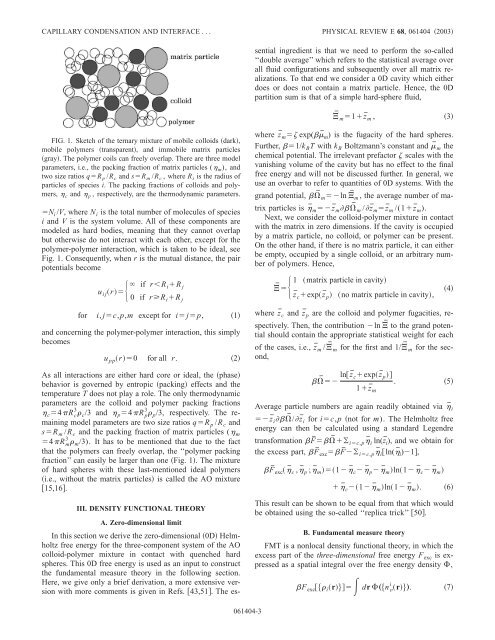Capillary condensation and interface structure of a model colloid ...
Capillary condensation and interface structure of a model colloid ...
Capillary condensation and interface structure of a model colloid ...
Create successful ePaper yourself
Turn your PDF publications into a flip-book with our unique Google optimized e-Paper software.
CAPILLARY CONDENSATION AND INTERFACE ...PHYSICAL REVIEW E 68, 061404 2003A. Zero-dimensional limitIn this section we derive the zero-dimensional 0D Helmholtzfree energy for the three-component system <strong>of</strong> the AO<strong>colloid</strong>-polymer mixture in contact with quenched hardspheres. This 0D free energy is used as an input to constructthe fundamental measure theory in the following section.Here, we give only a brief derivation, a more extensive versionwith more comments is given in Refs. 43,51. The essentialingredient is that we need to perform the so-called‘‘double average’’ which refers to the statistical average overall fluid configurations <strong>and</strong> subsequently over all matrix realizations.To that end we consider a 0D cavity which eitherdoes or does not contain a matrix particle. Hence, the 0Dpartition sum is that <strong>of</strong> a simple hard-sphere fluid,¯m1z¯m ,3FIG. 1. Sketch <strong>of</strong> the ternary mixture <strong>of</strong> mobile <strong>colloid</strong>s dark,mobile polymers transparent, <strong>and</strong> immobile matrix particlesgray. The polymer coils can freely overlap. There are three <strong>model</strong>parameters, i.e., the packing fraction <strong>of</strong> matrix particles ( m ), <strong>and</strong>two size ratios qR p /R c <strong>and</strong> sR m /R c , where R i is the radius <strong>of</strong>particles <strong>of</strong> species i. The packing fractions <strong>of</strong> <strong>colloid</strong>s <strong>and</strong> polymers, c <strong>and</strong> p , respectively, are the thermodynamic parameters.N i /V, where N i is the total number <strong>of</strong> molecules <strong>of</strong> speciesi <strong>and</strong> V is the system volume. All <strong>of</strong> these components are<strong>model</strong>ed as hard bodies, meaning that they cannot overlapbut otherwise do not interact with each other, except for thepolymer-polymer interaction, which is taken to be ideal, seeFig. 1. Consequently, when r is the mutual distance, the pairpotentials becomeu ij r if rR iR j0 if rR i R jfor i, jc,p,m except for i jp, 1<strong>and</strong> concerning the polymer-polymer interaction, this simplybecomesu pp r0 for all r. 2As all interactions are either hard core or ideal, the phasebehavior is governed by entropic packing effects <strong>and</strong> thetemperature T does not play a role. The only thermodynamicparameters are the <strong>colloid</strong> <strong>and</strong> polymer packing fractions c 4R c 3 c /3 <strong>and</strong> p 4R p 3 p /3, respectively. The remaining<strong>model</strong> parameters are two size ratios qR p /R c <strong>and</strong>sR m /R c <strong>and</strong> the packing fraction <strong>of</strong> matrix particles ( m4R m 3 m /3). It has to be mentioned that due to the factthat the polymers can freely overlap, the ‘‘polymer packingfraction’’ can easily be larger than one Fig. 1. The mixture<strong>of</strong> hard spheres with these last-mentioned ideal polymersi.e., without the matrix particles is called the AO mixture15,16.III. DENSITY FUNCTIONAL THEORYwhere z¯m exp(¯m) is the fugacity <strong>of</strong> the hard spheres.Further, 1/k B T with k B Boltzmann’s constant <strong>and</strong> ¯m thechemical potential. The irrelevant prefactor scales with thevanishing volume <strong>of</strong> the cavity but has no effect to the finalfree energy <strong>and</strong> will not be discussed further. In general, weuse an overbar to refer to quantities <strong>of</strong> 0D systems. With thegr<strong>and</strong> potential, ¯mln ¯m , the average number <strong>of</strong> matrixparticles is ¯mz¯m¯m /z¯mz¯m /(1z¯m).Next, we consider the <strong>colloid</strong>-polymer mixture in contactwith the matrix in zero dimensions. If the cavity is occupiedby a matrix particle, no <strong>colloid</strong>, or polymer can be present.On the other h<strong>and</strong>, if there is no matrix particle, it can eitherbe empty, occupied by a single <strong>colloid</strong>, or an arbitrary number<strong>of</strong> polymers. Hence,1 matrix particle in cavity¯ 4z¯cexpz¯p no matrix particle in cavity,where z¯c <strong>and</strong> z¯p are the <strong>colloid</strong> <strong>and</strong> polymer fugacities, respectively.Then, the contribution ln ¯ to the gr<strong>and</strong> potentialshould contain the appropriate statistical weight for each<strong>of</strong> the cases, i.e., z¯m /¯m for the first <strong>and</strong> 1/¯m for the second,¯ lnz¯cexpz¯p. 51z¯mAverage particle numbers are again readily obtained via ¯iz¯i¯/z¯i for ic,p not for m). The Helmholtz freeenergy can then be calculated using a st<strong>and</strong>ard Legendretransformation F¯¯ ic,p ¯i ln(z¯i), <strong>and</strong> we obtain forthe excess part, F¯exc F¯ ic,p ¯iln(¯i)1,F¯exc ¯c ,¯p ;¯m1¯c¯p¯mln1¯c¯m¯c1¯mln1¯m.This result can be shown to be equal from that which wouldbe obtained using the so-called ‘‘replica trick’’ 50.B. Fundamental measure theoryFMT is a nonlocal density functional theory, in which theexcess part <strong>of</strong> the three-dimensional free energy F exc is expressedas a spatial integral over the free energy density ,F exc i r dr „n i r….67061404-3
















